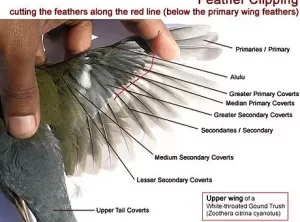EXO- Lesson 2- Beak, Nail and Wing Trims

Wild birds are naturally very active during the day and normally sit on a huge variety of perches of varying diameters and textures in their environments. This variety of surfaces, along with ordinary preening and grooming behavior, wears down their nails so that they do not overgrow. Unfortunately, in captivity, birds typically have smooth surfaced perches, all of the same or similar diameter. This lack of perch variability often results in decreased wear of nails and nail overgrowth. Without trimming, toenails may become long, very sharp, and/or flaky. Overgrown nails may become caught or trapped on toys, clothing, or parts of the cage. In these situations, parts of the toenail may be ripped off or may cause a broken toe, causing severe pain or blood loss.
The beak is a multipurpose organ used for eating, preening, grasping, climbing (like a third foot), self-defense, touching, playing, and communication. It is capable of great strength and gentle touch. The beak is constantly growing but in a normal healthy bird, tends to stay a relatively constant length, because the bird is always wearing it down at the tip as it eats, climbs, and plays. After a bird eats, you may see it wipe and clean its beak on an object in the cage, such as a perch. This action helps wear down the beak. A bird may also grind its upper and lower beak together, which further wears down the lower beak. Providing your bird with pet-safe toys and chewing activities will not only help wear down the beak, but also provide hours of entertainment for your pet.
As a rule, if a beak appears too long, your bird could have a health problem, such as liver disease, scaley beak and leg mites, or cancer of the beak, and it should be seen by your veterinarian. It is never advisable to attempt to trim your bird’s beak at home, as there is a large blood vessel running down the center of the beak that will bleed profusely if it is nicked. The tip of the upper beak has a substantial nerve supply and will cause pain if broken or trimmed improperly. A veterinarian familiar with birds will trim or grind the beak properly during regular health examinations if he or she finds that the upper or lower beak is elongated or misshapen.
Click Here to view a video on Beak, Wing and Nail Trims
Disclaimer- Pet Emergency Education and Pet Emergency Academy provide education and training based on the most current methods of animal care endorsed by licensed veterinarians. The content of the videos presented by third party in our training course has been selected based on the accuracy of the content presented. Pet Emergency Education and Pet Emergency Academy and the third party presenters are not liable for the outcome of the use of these skills by you, and/or on an animal in your care.
